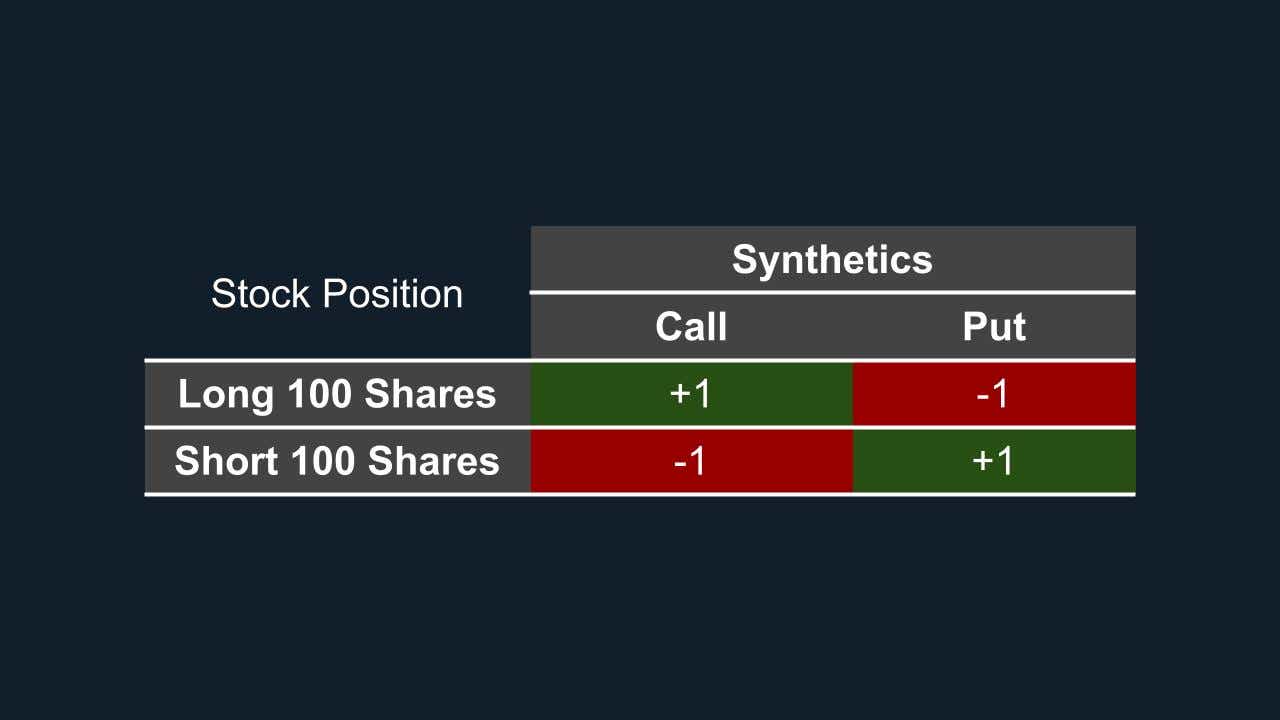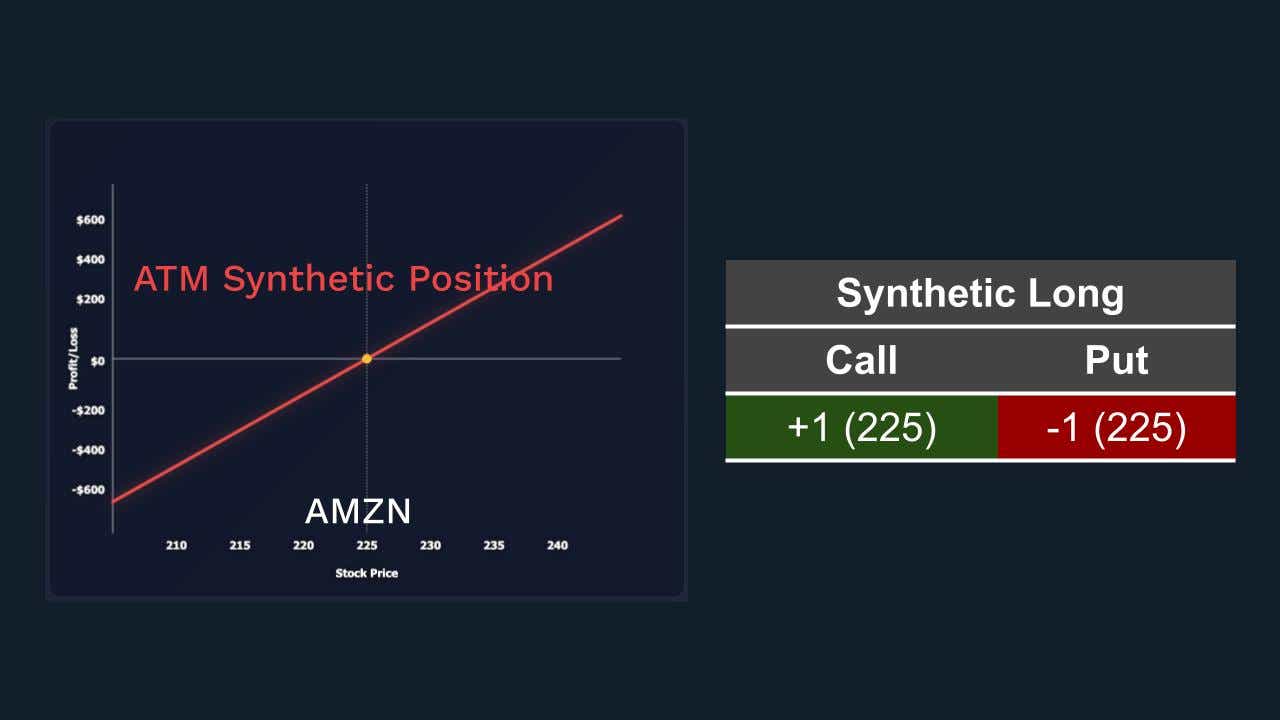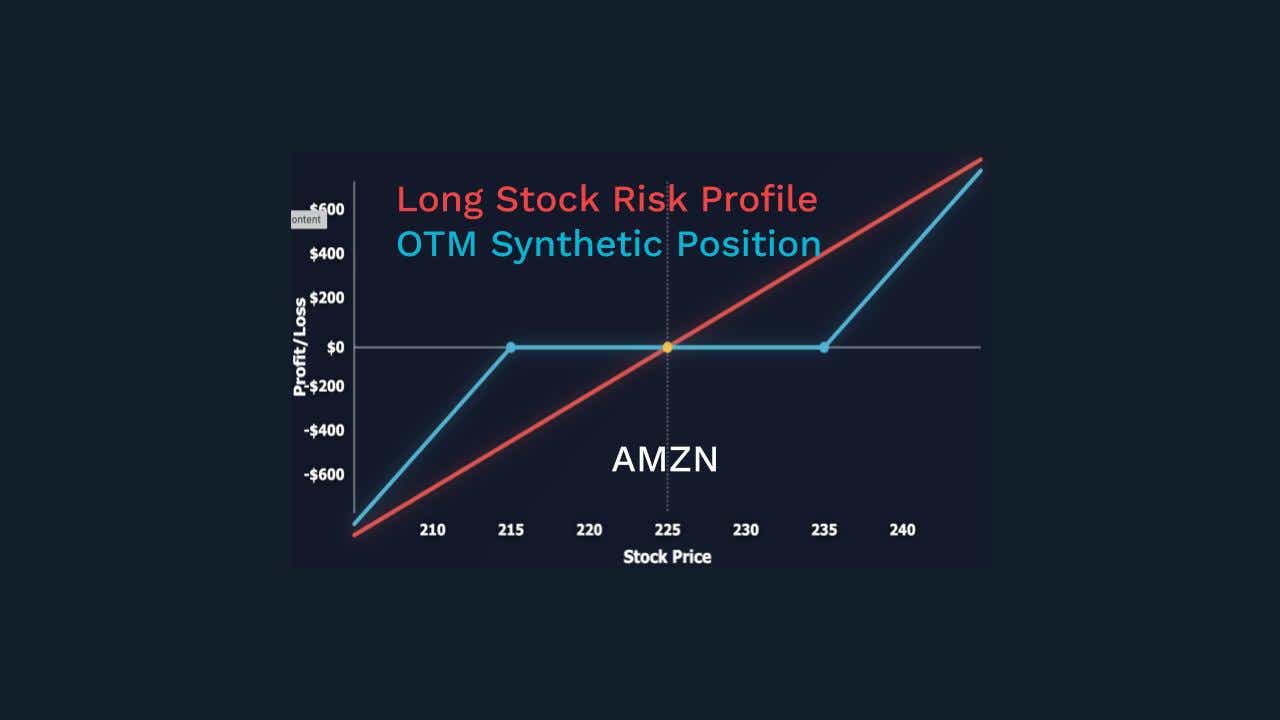Stock Exposure for Half the Cost

Stock Exposure for Half the Cost
By:Kai Zeng
Take advantage of synthetic options as a capital-efficient alternative
- Synthetic strategies provide an effective alternative to stock positions, significantly reducing buying-power requirements and improving win rates.
- These positions enable traders to modify directional exposure and risk profile more easily than traditional stock holdings.
- More active position management is essential for synthetic positions because they’re time-sensitive.
Trading stocks usually requires enough upfront capital to create barriers for many investors. Consider buying 100 shares of Amazon at $225 per share: It would require $11,250 in a regular margin account. For small-account traders seeking market exposure without such heavy capital requirements, synthetic options present a compelling alternative.
Synthetic positions use options combinations to create market exposure similar to direct stock ownership. Instead of buying shares outright, traders use options to create equivalent exposure.

Because options positions are much more flexible than simply long and short stock positions, traders can adjust the deltas on either or both put and call sides to meet their requirements. At minimum, the goal is to collect credit at order entry to avoid losing time value.
At-the-money synthetic positions closely mirror stock positions with a delta of nearly 100, providing almost identical directional sensitivity as owning 100 shares.

The probability of profit remains around 50%, similar to stock ownership, and the risk/reward profile maintains a linear relationship that matches stock performance. The key difference is capital efficiency, allowing traders to achieve equivalent exposure with much lower capital requirements. The reduced buying power requirement for Amazon synthetic options is $5,600, about 50% of a long 100 shares position.
Using out-of-the-money options instead can improve the position in several ways.
- It further reduces the BPR, which is $3,900 for 30-delta options in the Amazon case.
- OTM synthetics typically have lower delta (75 in this case), which reduces directional risk while still providing meaningful market exposure.

- The probability of profit increases to approximately 65% compared to the 50% chance with ATM options or stock positions.
- If traders enter the OTM synthetics for a credit rather than paying a debit, it slightly improves risk-adjusted returns.
The trade-off is a different risk profile between the two strikes. It requires the stock to move above the long strike to be profitable at expiration.

Some important factors need attention when managing synthetic positions:
- The position delta fluctuates continuously as the stock price moves and time passes, unlike stock positions which have a constant delta of 100 for holding 100 shares.
- At expiration, the delta becomes either 0 or 100 depending on where the stock closes relative to the strike prices. Traders may need to close or roll positions if the same synthetic position is still needed.
Kai Zeng, director of the research team and head of Chinese content at tastylive, has 20 years of experience in markets and derivatives trading. He cohosts several live shows, including From Theory to Practice and Building Blocks. @kai_zeng1
For live daily programming, market news and commentary, visit tastylive or the YouTube channels tastylive (for options traders), and tastyliveTrending for stocks, futures, forex & macro.
Trade with a better broker, open a tastytrade account today. tastylive, Inc. and tastytrade, Inc. are separate but affiliated companies.
Options involve risk and are not suitable for all investors. Please read Characteristics and Risks of Standardized Options before deciding to invest in options.
tastylive content is created, produced, and provided solely by tastylive, Inc. (“tastylive”) and is for informational and educational purposes only. It is not, nor is it intended to be, trading or investment advice or a recommendation that any security, futures contract, digital asset, other product, transaction, or investment strategy is suitable for any person. Trading securities, futures products, and digital assets involve risk and may result in a loss greater than the original amount invested. tastylive, through its content, financial programming or otherwise, does not provide investment or financial advice or make investment recommendations. Investment information provided may not be appropriate for all investors and is provided without respect to individual investor financial sophistication, financial situation, investing time horizon or risk tolerance. tastylive is not in the business of transacting securities trades, nor does it direct client commodity accounts or give commodity trading advice tailored to any particular client’s situation or investment objectives. Supporting documentation for any claims (including claims made on behalf of options programs), comparisons, statistics, or other technical data, if applicable, will be supplied upon request. tastylive is not a licensed financial adviser, registered investment adviser, or a registered broker-dealer. Options, futures, and futures options are not suitable for all investors. Prior to trading securities, options, futures, or futures options, please read the applicable risk disclosures, including, but not limited to, the Characteristics and Risks of Standardized Options Disclosure and the Futures and Exchange-Traded Options Risk Disclosure found on tastytrade.com/disclosures.
tastytrade, Inc. ("tastytrade”) is a registered broker-dealer and member of FINRA, NFA, and SIPC. tastytrade was previously known as tastyworks, Inc. (“tastyworks”). tastytrade offers self-directed brokerage accounts to its customers. tastytrade does not give financial or trading advice, nor does it make investment recommendations. You alone are responsible for making your investment and trading decisions and for evaluating the merits and risks associated with the use of tastytrade’s systems, services or products. tastytrade is a wholly-owned subsidiary of tastylive, Inc.
tastytrade has entered into a Marketing Agreement with tastylive (“Marketing Agent”) whereby tastytrade pays compensation to Marketing Agent to recommend tastytrade’s brokerage services. The existence of this Marketing Agreement should not be deemed as an endorsement or recommendation of Marketing Agent by tastytrade. tastytrade and Marketing Agent are separate entities with their own products and services. tastylive is the parent company of tastytrade.
tastyfx, LLC (“tastyfx”) is a Commodity Futures Trading Commission (“CFTC”) registered Retail Foreign Exchange Dealer (RFED) and Introducing Broker (IB) and Forex Dealer Member (FDM) of the National Futures Association (“NFA”) (NFA ID 0509630). Leveraged trading in foreign currency or off-exchange products on margin carries significant risk and may not be suitable for all investors. We advise you to carefully consider whether trading is appropriate for you based on your personal circumstances as you may lose more than you invest.
tastycrypto is provided solely by tasty Software Solutions, LLC. tasty Software Solutions, LLC is a separate but affiliate company of tastylive, Inc. Neither tastylive nor any of its affiliates are responsible for the products or services provided by tasty Software Solutions, LLC. Cryptocurrency trading is not suitable for all investors due to the number of risks involved. The value of any cryptocurrency, including digital assets pegged to fiat currency, commodities, or any other asset, may go to zero.
© copyright 2013 - 2025 tastylive, Inc. All Rights Reserved. Applicable portions of the Terms of Use on tastylive.com apply. Reproduction, adaptation, distribution, public display, exhibition for profit, or storage in any electronic storage media in whole or in part is prohibited under penalty of law, provided that you may download tastylive’s podcasts as necessary to view for personal use. tastylive was previously known as tastytrade, Inc. tastylive is a trademark/servicemark owned by tastylive, Inc.